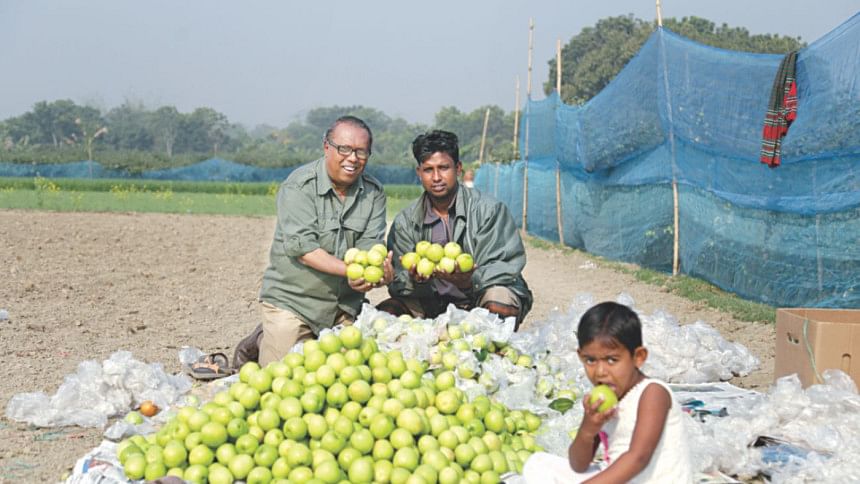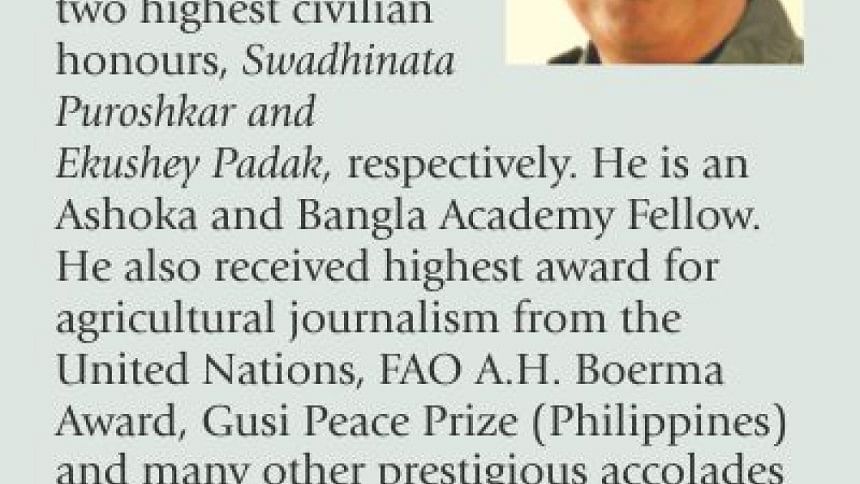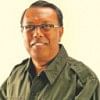Baukul boon for young farmer

In this country of six seasons, in the span of a couple years, autumn and winter are on the verge of extinction. Everyone of us are aware of it. From the early 80's onwards, I go to fields regularly. I can understand how these changes are taking place across the country. The average temperature in winter is increasing in the country. Especially the temperature of the capital and city areas is rising abruptly. Few days back, I went to Rakhalgachhi village located in Kaliganj upazila of Jhenidah. It was just in the middle of the Bengali month of Magh.
I heard about a successful young farmer from this village. In this region, there is a great combination of crop variations. Once, fields after fields were covered with rice. Now the crop fields have changed. Farmers are no longer dependent on a single crop. Farmers have found alternatives and diversified crops. Now these fields are filled with seasonal fruits, even flowers too. Once, these fruits and flowers were just fancy. Farmers brought them to the farmlands and established those as cash crops.
While I was discussing the change with the local farmers, a young man hugged me from behind. Farmers often do this. So, I was not surprised. I was surprised because the young farmer was trying to lift me up. He is not more than 30 in age. He was so excited seeing me.
He said, “Seraj Bhai, I have been looking forward to meeting you for the past 13 years now. Today, as you are in front of me, I couldn't hold myself.”
The young man's name is Harun-ur-Rashid. In fact, this was the man I was looking for. Rakhalgachi is not the village of Harun-or-Rashid. His house is in the nearby village Shanbandha. This year, he has cultivated baukul (Bau-plum) on a leased 4.5 bigha (1.80 acres) land in this village. Thirteen years ago, after seeing an episode on plum cultivation on Hridoye Mati O Manush, he decided to do it for a living. Since then, he is pursuing it. You will be surprised to know that in Shanbandha village, he is the first to commercially cultivate plums. The whole village has started plum cultivation following his footsteps. People know Shanbandha village as a plum village now. However, Harun achieved remarkable success this year in plum cultivation.
Dear readers, I have always said that Bangladeshi farmers have great innovative and indigenous skills. If you can give him a little guideline, he can develop the indigenous technology on his own. The same has happened with Harun too. And that has brought Harun a bumper harvest of plums. I would really love to share Harun's successful story with you.

Before that, let me give you statistics regarding plum cultivation in Bangladesh. According to the information provided by the Department of Agricultural Extension, the total production was 1,75,461 tonnes from a total of 17,586 hectares of land during 2017-2018 fiscal year. Every year the cultivation of plum is increasing throughout the country. During the winter season, plum has secured a significant place in the list of farmer's cash crops. From smallholder farmers to new entrepreneurs, many are going for plum cultivation. Plum farming is now one of the main sources of added yearly income for many farmers. People are choosing this nutrient-rich fruit to become commercially successful in a short time with a small investment. In many regions across the country, plum orchards are being grown on vast fields.
I was talking about Harun's innovative strategy. Using this technique, along with a bumper harvest, he has got big profits this year. Harun noticed that the guavas which are 'poly-bagged' grow bigger in size, sweeter in taste. From his very own idea, he applied this method on his plums. He found out this strategy is working. Truly the plums which have been poly-bagged grew bigger in size and sweeter in taste than the rest. Seeing his experiments working well, he spread the poly-bagging massively across the plum orchard.
Harun bought 100 kg of poly-bags and bagged nearly 100 thousand plums. Only six plums weighs 1 kg. Meaning, each plum is about 200 gram. He is selling each kilo for 110 taka (1.3 USD). The preparation of sales happens in the field, packaging activities beside the orchard. He packaged nine cartons of plums in one day. Each carton contains 55 kg of plums. Meaning, he is getting nearly 500 kg of fruits every day on average. Due to the poly-bagging method, plums remain protected from insects. There is no need of applying pesticide. So, plums don't get any stain. Thus, his plums have great demand in the market and Harun's getting a good price as I have already mentioned.
Dear readers, diversified farming has changed Harun's fortune. Harun says, "Thirteen years ago, on your show I found my dream. I didn't stop there. I chased it. Choose plum cultivation as profession. I have made my dream come true step by step with my effort. Now, I know what the soil can give me in return.”
Harun is getting an average of 35,000 taka (418 USD) worth of plums every day from 765 one-year-old-plum trees from a land of nearly1.80 acres. He harvests fruits from one-year plum trees. Every year, he plants new trees. Harun is doing it beside his rice field, which means he's also producing the staple simultaneously.
Not only plum cultivation, Harun has guava and sharifa (custard-apple) orchards too. In a word, Harun's main goal is to cultivate high value crops. From which, Harun has managed to settle down today. His family depends on him. He made all the arrangements for sending his younger brother to Singapore. Seven day-labourers work with Harun and they are quite happy to be here.
Dear readers, farmers play the key role in agricultural extension. Harun's tale of plum cultivation is the same. Thanks to him that new plum orchards are being established in the area and more farmers are getting interested to take up plum cultivation besides doing other crops. Plum is not only changing the life of Harun and farmers alike, but also has become a bright example in the agricultural diversity of the entire area. It is an inspiration for many other in the country.

 For all latest news, follow The Daily Star's Google News channel.
For all latest news, follow The Daily Star's Google News channel. 



Comments